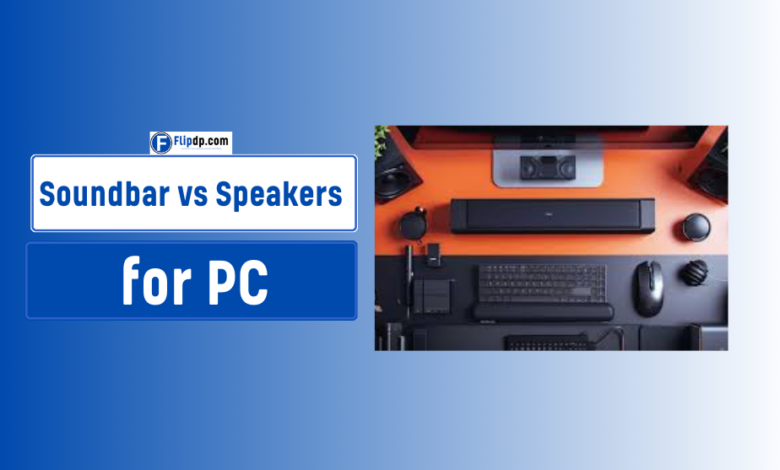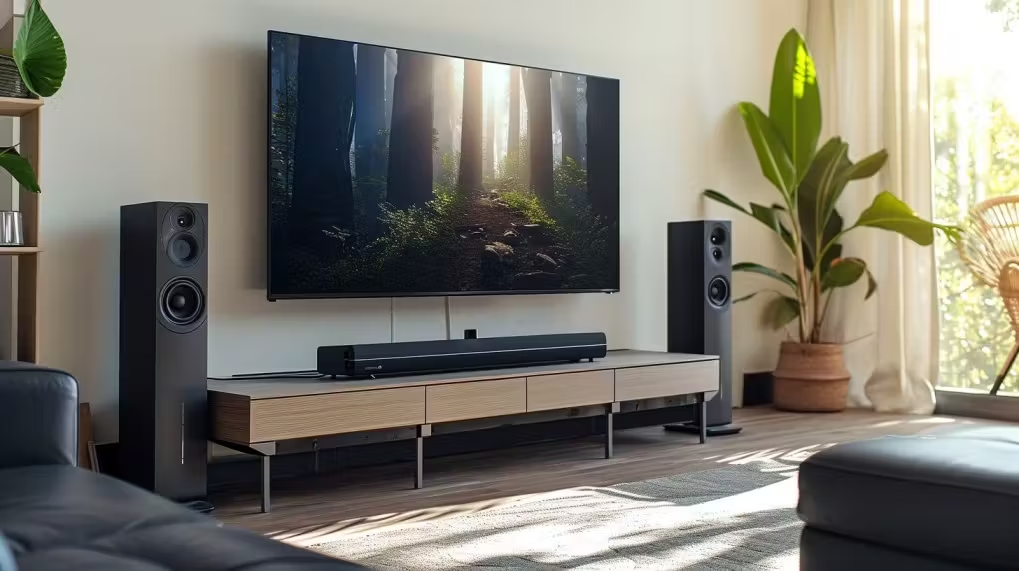Soundbar vs Speakers for PC: Choosing the Perfect Audio Solution

soundbar vs speakers for pc, When it comes to enhancing your PC audio experience, the choice between a soundbar and speakers is pivotal. With the evolution of audio technology, understanding the nuances of these two options will help you make an informed decision tailored to your needs. This article delves into the intricacies of soundbars and speakers, exploring their features, sound quality, and suitability for various applications like gaming, music, and movie-watching.
Understanding Soundbars: The Basics

Soundbars are compact, elongated speakers designed to produce high-quality audio in a single unit. They typically consist of multiple speaker drivers housed within a sleek design, making them an aesthetically pleasing addition to any setup.
Most soundbars include features like built-in subwoofers and Bluetooth connectivity, providing a rich audio experience without the clutter of multiple speakers. They are particularly popular for home theater setups, where space can be a premium, yet immersive sound is desired.
Soundbars aim to replicate a surround sound experience, offering a better audio solution for movies and gaming than standard PC speakers. Their design is often optimized to project sound outward, filling a room more effectively than traditional audio systems.
Exploring Different Types of Speakers for PC
When discussing speakers for PC, various types cater to different audio preferences and setups. Stereo speakers are the most common, offering a two-channel sound system ideal for general listening. They provide a balanced audio experience for music and everyday computer tasks. 2.1 speaker systems add a subwoofer for enhanced bass, making them suitable for gaming and action-packed movies.
Bookshelf speakers are another popular option, offering higher audio fidelity due to their larger drivers and cabinets. These speakers are typically wired and require more space than soundbars, but they deliver superior sound quality for audiophiles.
Wireless speakers, including Bluetooth options, provide flexibility and eliminate cable clutter, making them suitable for various setups. However, users should be mindful of potential latency issues when using wireless systems for gaming or fast-paced video content.
Comparing Sound Quality: Soundbar vs Speakers

Sound quality is a significant factor in the soundbar vs speakers debate. Soundbars can provide an impressive audio experience, particularly with built-in subwoofers, which enhance bass response. Many modern soundbars utilize advanced technologies like Dolby Atmos, delivering an immersive surround sound experience that can compete with traditional speaker setups.
On the other hand, speakers can often provide clearer and more detailed sound across a broader frequency range. High-quality speakers, particularly bookshelf models, are designed for optimal sound reproduction and can be customized with external amplifiers for improved audio performance.
The choice between a soundbar and speakers often comes down to personal preference, with some users favoring the convenience and compact design of soundbars, while others prefer the richness and clarity of a dedicated speaker system.
The Role of Audio Quality in PC Audio Solutions
Audio quality is paramount for anyone seeking a superior listening experience. The clarity, depth, and fidelity of sound can dramatically affect how you enjoy music, movies, and games. For gamers, audio quality can enhance immersion, allowing for better situational awareness and engagement with the game world.
When evaluating audio quality, consider factors such as frequency response, total harmonic distortion (THD), and soundstage. High-quality audio solutions—whether soundbars or speakers—should produce a clear, balanced sound with minimal distortion across various volume levels.
Key Features of Modern Soundbars
Modern soundbars come equipped with various features that enhance the user experience:
- Bluetooth and Wi-Fi Connectivity: Allow for seamless wireless audio streaming from devices like smartphones and tablets.
- Surround Sound Technology: Many soundbars incorporate Dolby Atmos and DTStechnologies, enabling a more immersive audio experience.
- Built-in Subwoofers: These provide deeper bass without the need for a separate unit, ideal for compact setups.
- Voice Control and Smart Features: Some soundbars integrate with smart home systems, enabling voice commands for playback and settings adjustments.
These features make soundbars a compelling choice for those seeking both quality and convenience in their PC audio setup.
Benefits of Using Speakers for PC Audio

Using speakers for PC audio comes with several advantages:
- Superior Sound Quality: Dedicated speakers, especially high-end models, often deliver better audio fidelity than soundbars.
- Customizability: Users can mix and match various components (e.g., adding a subwoofer or upgrading amplifiers) to create a personalized audio experience.
- Wider Soundstage: Traditional speaker setups can create a more immersive sound environment, particularly in larger rooms.
For music enthusiasts and audiophiles, speakers offer a tailored audio experience that often surpasses the capabilities of soundbars.
The Importance of Surround Sound in Gaming
Surround sound is critical in gaming as it provides a more immersive experience, allowing players to pinpoint the direction of sounds—be it footsteps behind them or gunfire in the distance. Many soundbars are designed to simulate surround sound through multiple audio channels, enhancing gameplay.
Traditional speakers can also provide an authentic surround sound experience when configured correctly. A 5.1 or 7.1 speaker system can deliver superior directional sound, allowing gamers to fully engage with their environment.
Setting Up the Perfect Audio System for Your PC
Creating an ideal audio system involves more than just choosing between soundbars and speakers. Here are key considerations for setting up:
- Room Size and Layout: The dimensions of your space will dictate the type of audio system you can use effectively. Smaller rooms may benefit from soundbars or compact speakers, while larger rooms might accommodate larger speaker systems.
- Usage Needs: Consider whether you primarily listen to music, play games, or watch movies. This will influence your choice of audio solution.
- Connectivity Options: Ensure your sound system is compatible with your PC’s audio output options, whether it be HDMI, optical, or USB.
By taking these factors into account, you can create a balanced and effective audio setup that meets your needs.
Soundbar Placement Tips for Optimal Performance
Proper placement of a soundbar is crucial for maximizing audio quality. Here are tips for optimal soundbar positioning:
- Height: Ideally, the soundbar should be at ear level when seated. If wall-mounted, position it slightly below the television screen for the best auditory experience.
- Distance from Wall: Allow some space between the soundbar and the wall to enhance sound dispersion and bass response.
- Avoid Obstructions: Ensure that nothing blocks the soundbar’s speakers to prevent distortion or muffled sound.
These placement strategies will enhance your listening experience, ensuring you get the most out of your soundbar.
Speaker Placement Strategies for Enhanced Audio
For traditional speakers, placement is equally important:
- Distance from Walls: Keep speakers at least a few inches away from walls to minimize unwanted reflections and improve sound clarity.
- Angles: Position speakers at an angle toward the listening area, which enhances the soundstage and depth.
- Height: Ideally, the tweeters (high-frequency drivers) should be at ear level for the best listening experience.
By following these strategies, you can optimize the audio performance of your speaker system.
Choosing Between Wireless and Wired Speakers
When selecting speakers for your PC, you’ll need to choose between wireless and wired options. Wireless speakers offer convenience, eliminating the need for cables and allowing for flexibility in placement. They are especially beneficial in small spaces where cable management can be an issue. However, they may introduce latency, which can be detrimental for gaming.
Wired speakers typically provide superior sound quality and reliability, as they are not subject to interference or signal loss. They are often preferred by audiophiles and serious gamers who prioritize performance over convenience.
An Overview of Compact Audio Solutions for Small Spaces
For users with limited space, compact audio solutions like soundbars or mini speakers can provide excellent audio quality without taking up too much room. These options are designed to fit snugly into smaller environments while still delivering impressive sound. Brands are increasingly focusing on creating powerful soundbars and speakers that are both compact and capable of delivering high-quality audio, making them ideal for desktops, dorm rooms, or small apartments.
Budget-Friendly Options for PC Speakers
For those looking to enhance their PC audio without breaking the bank, there are numerous budget-friendly speaker options available. Look for stereo speakers or compact 2.1 systems that offer solid audio performance at a lower price point. Many brands produce quality speakers under $100 that provide good sound clarity and decent bass response, making them excellent choices for gaming and music.
High-End Soundbars for Audiophiles
For audiophiles seeking the ultimate audio experience, investing in high-end soundbars can provide exceptional sound quality and advanced features. Models that incorporate multi-driver systems and support high-definition audio formats will deliver an unparalleled listening experience, making them suitable for music lovers and home theater enthusiasts alike.
When shopping for a high-end soundbar, look for features like Dolby Atmos support, advanced equalizers, and multiple connectivity options to ensure you get the best audio experience possible.
Essential Audio Equipment for Gamers
Gamers often require specialized audio equipment to enhance their experience. Beyond choosing between soundbars and speakers, consider investing in a dedicated gaming headset for immersive audio. For those opting for speakers, adding a subwoofer can significantly enhance low-frequency sounds, improving overall audio performance during gaming sessions.
Exploring the Benefits of a 2.1 Speaker System
A 2.1 speaker system combines two satellite speakers with a subwoofer, providing an excellent balance between audio clarity and bass response. This setup is ideal for users who enjoy music, movies, or gaming, as it offers richer sound than standard stereo systems. The subwoofer handles low-frequency sounds, delivering impactful bass that enhances audio experiences, particularly in action-packed gaming and movie scenes.
The satellite speakers, designed for mid to high frequencies, ensure that dialogues, musical notes, and sound effects are clear and well-defined. This two-piece design allows for a more dynamic soundstage, which is particularly beneficial in gaming, where directional audio cues can enhance gameplay. The integration of the subwoofer ensures that users feel the audio rather than just hearing it, creating a more immersive experience.
How Soundbars Enhance the Movie Watching Experience
Soundbars have revolutionized how users experience movies at home. They are designed to replicate a surround sound experience in a single unit, making them an excellent choice for those who want cinematic audio without the complexity of multiple speakers. When watching movies, soundbars enhance the overall experience by providing clearer dialogue and impactful sound effects.
Most modern soundbars support various audio formats, including Dolby Atmos and DTS, which create a three-dimensional audio experience, allowing sound to move around the listener. This spatial sound adds depth to action scenes and enhances the emotional impact of dialogues, making viewers feel as if they are part of the movie.
Additionally, many soundbars come equipped with features like voice enhancement and night mode, allowing users to customize their audio experience based on their viewing environment. The sleek design of soundbars means they can be mounted on the wall or placed in front of a TV without taking up much space, making them an attractive addition to any home theater setup.
Evaluating the Pros and Cons of Soundbars
While soundbars offer numerous advantages, they also have their drawbacks. Understanding these can help users make informed decisions regarding their audio solutions.
Pros:
- Space-saving design: Soundbars are compact and can be placed easily, making them ideal for small spaces.
- Simplicity: They often come with user-friendly controls and can be connected with minimal cables, which is perfect for users who want a hassle-free setup.
- Cost-effective: For those on a budget, soundbars provide an affordable solution to improve audio quality without the expense of a full surround sound system.
Cons:
- Limited soundstage: While soundbars can simulate surround sound, they may not match the audio immersion of a dedicated multi-speaker system.
- Bass limitations: Although many soundbars come with built-in subwoofers or support for external ones, they can still fall short in delivering the deep bass that larger speaker systems can provide.
- Less flexibility: Unlike traditional speaker systems, soundbars do not allow for customization in speaker placement, which can affect audio quality in certain setups.
The Future of Audio Solutions for PCs
As technology evolves, so does the landscape of audio solutions for PCs. The future is likely to see advancements in wireless technology, allowing for seamless connectivity between devices. This will enhance user experience by eliminating the need for cumbersome cables and improving the aesthetic of audio setups.
Furthermore, smart soundbars with integrated voice assistants will become more common, allowing users to control their audio systems with voice commands. This integration will make it easier to switch between different audio sources, control volume, and adjust settings without needing a remote.
Additionally, the rise of spatial audio technologies will continue to shape the way users experience sound, providing more immersive and dynamic audio environments. As gaming and entertainment become more interactive, audio solutions will increasingly focus on delivering experiences that engage users and bring content to life.
Choosing the Right Speaker for Music Lovers
For music enthusiasts, the choice between soundbars and speakers can significantly impact their listening experience. While soundbars offer convenience and simplicity, dedicated speakers often provide superior audio quality and a more authentic representation of sound.
Stereo speakers, particularly those designed for high fidelity, can reproduce a wider range of frequencies and deliver a more nuanced listening experience. For those who prioritize sound quality and have the space for a more extensive setup, investing in a good pair of speakers is often the better choice.
Additionally, audiophiles may prefer bookshelf speakers or floor-standing models that deliver exceptional sound quality for various music genres. Users should consider their listening habits, space constraints, and budget when selecting the right audio solution.
Top Soundbars for PC Gaming in 2024
As gaming continues to grow, so does the demand for high-quality audio solutions. In 2024, several soundbars are particularly well-suited for gaming:
- Razer Leviathan: Known for its immersive sound and customizable settings, this soundbar is designed specifically for gamers and offers Bluetooth connectivity for easy pairing with PCs.
- Bose Soundbar 700: With superior audio performance and voice control capabilities, this soundbar enhances gaming sessions by providing clear sound and impactful bass.
- Sonos Beam: Featuring an elegant design and smart home integration, the Sonos Beam delivers impressive sound quality and is versatile enough for gaming, movies, and music.
- LG SK9Y: This soundbar supports Dolby Atmos and DTS, creating a 3D audio experience that elevates gaming and cinematic adventures.
- Samsung HW-Q70T: With powerful sound and an included subwoofer, this soundbar enhances every gaming experience by delivering rich audio and excellent connectivity options.
A Guide to Home Theater Audio Setups
Creating a home theater audio setup requires careful consideration of space, equipment, and personal preferences. Here are some essential tips for setting up a successful home theater audio system:
- Room Size and Shape: The size and shape of the room significantly influence audio quality. Larger rooms may require more powerful speakers or a full surround sound system, while smaller spaces can benefit from soundbars or compact speaker systems.
- Speaker Placement: Proper speaker placement is crucial for achieving optimal sound. Surround speakers should be positioned at ear level and angled towards the listening area, while the subwoofer can be placed in various locations to find the best bass response.
- Acoustic Treatment: Consider adding acoustic panels or rugs to minimize sound reflections and enhance audio clarity. This is especially important in larger rooms where sound can bounce off hard surfaces.
- Receiver Selection: Invest in a good audio receiver to ensure your speakers and soundbar are adequately powered. This will provide a more immersive audio experience and allow for various connectivity options.
- Calibration: Take the time to calibrate your audio system for your specific room. Many receivers offer automatic calibration tools to optimize sound settings based on speaker placement and room acoustics.
Understanding Audio Performance Metrics
When evaluating audio solutions, understanding key performance metrics can help users make informed decisions. Important metrics to consider include:
- Frequency response: This measures the range of frequencies a speaker can reproduce, typically expressed in Hertz (Hz). A wider frequency range generally leads to better sound quality.
- Total harmonic distortion (THD): This indicates the amount of distortion present in the audio signal. Lower THD values typically correlate with clearer sound reproduction.
- Sensitivity: Measured in decibels (dB), sensitivity indicates how efficiently a speaker converts power into sound. Higher sensitivity ratings mean less power is needed to produce sound at the same volume.
- Power handling: This measures the maximum power a speaker can handle without distortion or damage. It’s essential to match speaker power handling with the output of your audio receiver for optimal performance.
Exploring Multi-Room Audio Systems
Multi-room audio systems allow users to enjoy their favorite music throughout their homes seamlessly. By connecting multiple speakers or soundbars, users can create a unified audio experience that enhances everyday life.
These systems often support streaming services and can be controlled via mobile apps or smart home devices, providing convenience and flexibility. As technology continues to improve, multi-room audio systems will become increasingly accessible and user-friendly, allowing for personalized listening experiences across different spaces.
The Evolution of PC Audio Equipment
The evolution of PC audio equipment has seen significant advancements in technology, design, and functionality. From basic built-in speakers to high-end sound systems, users now have access to a wide range of options that cater to various needs and preferences.
This evolution has also been driven by the rise of gaming, music production, and home theater setups, pushing manufacturers to innovate and create solutions that meet the demands of discerning users. As more individuals invest in quality audio equipment, the future of PC audio looks promising, with continued advancements in sound technology and design.
High-Performance Sound Solutions for Music and Movies
High-performance sound solutions are essential for those who prioritize audio quality for both music and movies. Investing in quality speakers or soundbars can make a significant difference in the overall audio experience, whether it’s the clarity of vocals in music or the impact of sound effects in movies.
Users should consider factors such as audio clarity, frequency response, and overall design when selecting high-performance sound solutions. Additionally, looking for systems that offer compatibility with modern audio formats can further enhance the listening experience.
Assessing the Sound Quality of Popular Soundbars
When considering soundbars, evaluating their sound quality is crucial. Look for features such as built-in subwoofers, surround sound capabilities, and compatibility with various audio formats. User reviews and expert opinions can provide valuable insights into the performance of specific models.
Listening tests can also be beneficial. When possible, try out soundbars in-store to determine how they handle different audio types, from music to movie soundtracks. This hands-on approach can provide a clearer understanding of a soundbar’s performance, allowing users to compare various models based on their unique audio characteristics. Here are some key factors to evaluate during listening tests:
- Clarity and Detail: Pay attention to how clearly the soundbar reproduces vocals and instruments. Look for models that maintain clarity at various volume levels, ensuring dialogue in movies and lyrics in music are easily understandable.
- Bass Response: Evaluate the bass performance, especially for action movies or bass-heavy music genres. A good soundbar should produce deep, rich bass without distortion. If possible, listen to tracks that emphasize low frequencies to assess the subwoofer’s effectiveness.
- Soundstage: A soundbar should create a sense of space, allowing users to perceive sounds coming from different directions. During the listening test, notice if the soundstage feels immersive and if sound effects can be spatially identified.
- Dynamic Range: Listen for the soundbar’s ability to handle both quiet and loud sounds effectively. The dynamic range is crucial for an enjoyable listening experience, especially during scenes with sudden changes in volume.
- Compatibility with Audio Formats: Check if the soundbar supports advanced audio formats like Dolby Atmos or DTS, which can enhance the immersive experience when watching movies or playing games.
Understanding Audio Formats and Their Impact
Familiarizing yourself with different audio formats can significantly impact your choice of soundbars or speaker systems. Here are some common formats:
- Stereo: The most basic format, delivering sound from two channels. Ideal for music but lacks the immersive qualities of surround sound.
- Dolby Digital: A widely used audio format that provides a multi-channel sound experience, commonly found in DVDs and streaming services.
- DTS: Similar to Dolby Digital, DTS offers high-quality multi-channel sound and is frequently used in home theater systems.
- Dolby Atmos: An advanced audio format that adds height channels to the surround sound experience, creating a three-dimensional sound environment. It enhances immersion in movies and games by allowing sounds to move above and around the listener.
- MQA (Master Quality Authenticated): A format designed for high-resolution audio streaming. MQA delivers studio-quality sound, making it popular among audiophiles.
Understanding these formats can help users make informed decisions about their audio systems and ensure compatibility with their favorite media sources.
Customizing Audio Settings for Your PC Setup
Customizing audio settings is crucial for achieving the best sound quality from your PC audio system, whether you opt for a soundbar or traditional speakers. Most modern operating systems, such as Windows and macOS, offer built-in audio settings that allow users to tailor their audio experience according to their preferences and the capabilities of their equipment.
Start by accessing the sound settings on your PC. Here, you can adjust the output device, select the appropriate audio format, and configure advanced properties like sample rate and bit depth. Selecting the correct output device is essential—if you have both speakers and a soundbar connected, ensure the system is set to the desired output to avoid sound discrepancies.
Equalizer Settings: One of the most significant features available is the equalizer. This tool allows you to adjust the balance of different frequency bands (bass, midrange, and treble). If you find that your soundbar lacks bass for movies or that your speakers produce harsh highs for music, adjusting these settings can drastically improve the listening experience. Experiment with different presets, such as “Rock,” “Jazz,” or “Classical,” to see which best suits your listening habits.
Virtual Surround Sound: Many soundbars come equipped with virtual surround sound features designed to simulate a multi-channel experience from a two-channel system. While this can enhance immersion, it may not always work well with all types of audio. Try toggling this feature on and off during different audio sessions to determine its impact on your listening experience. For traditional speaker setups, software solutions can create virtual surround sound if you have a multi-channel speaker system.
Lastly, ensure that any audio enhancements offered by your audio drivers or sound card are appropriately configured. Features like “Loudness Equalization” can help improve overall sound consistency, especially when transitioning between different media types.
The Impact of Speaker Design on Sound Quality
The design of speakers—whether they are bookshelf speakers, floor-standing models, or soundbars—plays a pivotal role in determining their overall sound quality and performance. Various factors such as driver configuration, cabinet construction, and materials used in the design contribute to how well a speaker reproduces sound.
Driver Configuration: At the core of any speaker system are its drivers. Most speakers use a combination of woofers, midrange drivers, and tweeters. Woofers handle low frequencies, midrange drivers manage the middle frequencies, and tweeters are responsible for high frequencies. In soundbars, these drivers are often positioned to create a wider soundstage, but they may not produce bass as effectively as dedicated subwoofers. Users looking for rich bass response should consider systems that incorporate a separate subwoofer, whether through a soundbar with an included sub or a standalone speaker setup.
Cabinet Construction: The materials and construction of a speaker’s cabinet also significantly impact sound quality. A well-constructed cabinet reduces unwanted resonances, leading to cleaner sound. Manufacturers often use MDF (Medium Density Fiberboard) for its acoustic properties. Additionally, the design can affect how sound disperses in a room. For instance, front-firing speakers direct sound towards the listener, while rear-firing models can create a more ambient sound but may require careful placement for optimal performance.
Port Design: Many speakers include ports, which are openings that enhance bass response. Sealed cabinets offer tight, controlled bass, while ported designs allow for deeper low frequencies. Soundbars typically have a more compact design, which can limit bass performance unless paired with an external subwoofer. Understanding how these design elements affect sound quality can help users select the right audio system for their listening environment.
Key Considerations for Upgrading Your Audio System
Upgrading your audio system can be a rewarding experience, particularly if you want to enhance your PC’s sound quality. However, several factors should be taken into consideration to ensure you make the best investment.
Compatibility: Before purchasing new audio equipment, confirm that it is compatible with your existing system. Check for connection types (HDMI, optical, USB, or Bluetooth) and whether your sound card or audio interface can support the new equipment. Some high-end soundbars may require specific connections or audio formats, so researching beforehand can save you time and effort.
Room Acoustics: The acoustics of your room can significantly influence sound quality. Hard surfaces like tile or hardwood floors can reflect sound waves, causing echoes and muddiness. If possible, consider adding acoustic treatments such as rugs, curtains, or wall panels to absorb sound and improve clarity. When upgrading your audio system, think about how the new equipment will interact with your room’s acoustics.
Future-Proofing: Technology is continually evolving, and investing in future-proof audio solutions can save you from needing frequent upgrades. Look for systems that support the latest audio formats, such as Dolby Atmos or advanced wireless protocols like Wi-Fi audio streaming. Additionally, some soundbars and speakers come with firmware updates that can enhance performance over time.
Budget Considerations: Audio upgrades can range from budget-friendly to premium prices. Set a realistic budget based on your needs and consider whether investing in a soundbar, speaker system, or both aligns with your audio goals. Often, it’s wise to prioritize the most impactful components first, such as a high-quality subwoofer or a soundbar, before expanding to additional speakers.
Exploring User Reviews: Soundbars vs Speakers
User reviews are an invaluable resource when considering audio equipment, providing insights into real-world performance, durability, and user satisfaction. Both soundbars and traditional speakers have their advocates, and understanding the experiences of others can guide your decision-making process.
When examining reviews, look for detailed feedback on key performance metrics like audio quality, connectivity options, and ease of use. Users often share their experiences with specific features, such as Bluetooth connectivity, app integration, or remote control functionality. For soundbars, pay particular attention to how well they perform in different environments, such as small versus large rooms.
Additionally, many reviews offer comparative insights. Users may share their preferences for soundbars over traditional speakers or vice versa, detailing their reasons based on factors like space limitations, sound quality, or aesthetic considerations. Reading both positive and negative reviews can provide a balanced perspective, helping you identify potential pros and cons of each audio solution.
When exploring reviews, consider trusted sources such as audio forums, tech blogs, and retail websites that feature user-generated content. Engaging in discussions on platforms like Reddit can also yield helpful insights and recommendations from fellow audio enthusiasts.
Trends in PC Audio Equipment for 2024
The world of PC audio equipment is continually evolving, with new technologies and trends emerging each year. Staying informed about the latest advancements can help you make the best audio choices for your setup.
Wireless Technology: Wireless audio solutions are gaining popularity, offering convenience and eliminating clutter from cables. Many new soundbars and speakers support advanced Bluetooth and Wi-Fi protocols, enabling high-quality audio streaming without sacrificing sound fidelity. Look for models that feature low-latency technologies, ensuring synchronized audio for gaming and video playback.
Smart Home Integration: As smart home technology advances, more audio systems are integrating with smart assistants like Amazon Alexa or Google Assistant. This integration allows users to control their audio equipment using voice commands, making it easier to manage playlists, adjust volume levels, or switch inputs without needing to fumble with remotes.
High-Resolution Audio Support: There’s a growing demand for high-resolution audio formats, leading many manufacturers to incorporate support for technologies like MQA (Master Quality Authenticated) and DSD (Direct Stream Digital). These formats allow for studio-quality sound, appealing to audiophiles who seek the highest level of audio fidelity.
Modular Systems: Some manufacturers are introducing modular audio systems that allow users to customize their setups. This approach enables users to mix and match components, such as adding additional speakers or subwoofers, to create a tailored audio experience that suits their preferences and space.
Focus on Gaming Audio: As gaming continues to grow in popularity, there’s an increasing emphasis on audio solutions designed specifically for gamers. Products featuring surround sound capabilities, customizable audio profiles, and RGB lighting are becoming more prevalent, catering to the immersive needs of gaming enthusiasts.
Conclusion
In conclusion, the choice between soundbars and speakers for your PC largely depends on personal preferences, space constraints, and intended use. Soundbars offer a compact solution that enhances audio quality with minimal setup, while traditional speakers provide superior sound fidelity and customization options for audiophiles and gamers alike.
By understanding the various factors discussed in this article from speaker design to user reviews and emerging trends you can make an informed decision that elevates your audio experience.
Whether you’re enjoying movies, music, or gaming, investing in the right audio solution will transform your PC into an immersive entertainment hub, allowing you to appreciate sound like never before.
FAQs, soundbar vs speakers for pc
1. What’s the difference between a soundbar and PC speakers?
Soundbars are single, elongated speakers designed to project sound across a wide area, often used for TVs and multimedia setups. PC speakers usually come as a pair or more, designed specifically for near-field listening and providing stereo or surround sound for close-up use.
2. Which provides better sound quality for PC use, a soundbar or speakers?
PC speakers typically offer better sound quality for close-up listening, especially for gaming or music production, due to their stereo separation. Soundbars, while delivering a more immersive experience for movies and casual music listening, may lack the precise soundstage that speakers offer.
3. Are soundbars good for gaming on a PC?
Soundbars can enhance gaming with their wide sound projection, but PC speakers often deliver better spatial audio and stereo separation, which is crucial for competitive gaming where directional sound cues matter.
4. Can I use a TV soundbar for my PC?
Yes, you can connect a TV soundbar to your PC, usually via Bluetooth, HDMI, or AUX cable. However, some TV soundbars may not be optimized for close-range audio, so the sound quality may differ compared to speakers designed for PC use.
5. Do soundbars have better bass than PC speakers?
Soundbars often come with a built-in subwoofer or a separate one, providing better bass than standard PC speakers. However, some high-end PC speaker systems with dedicated subwoofers can also deliver strong bass performance.




